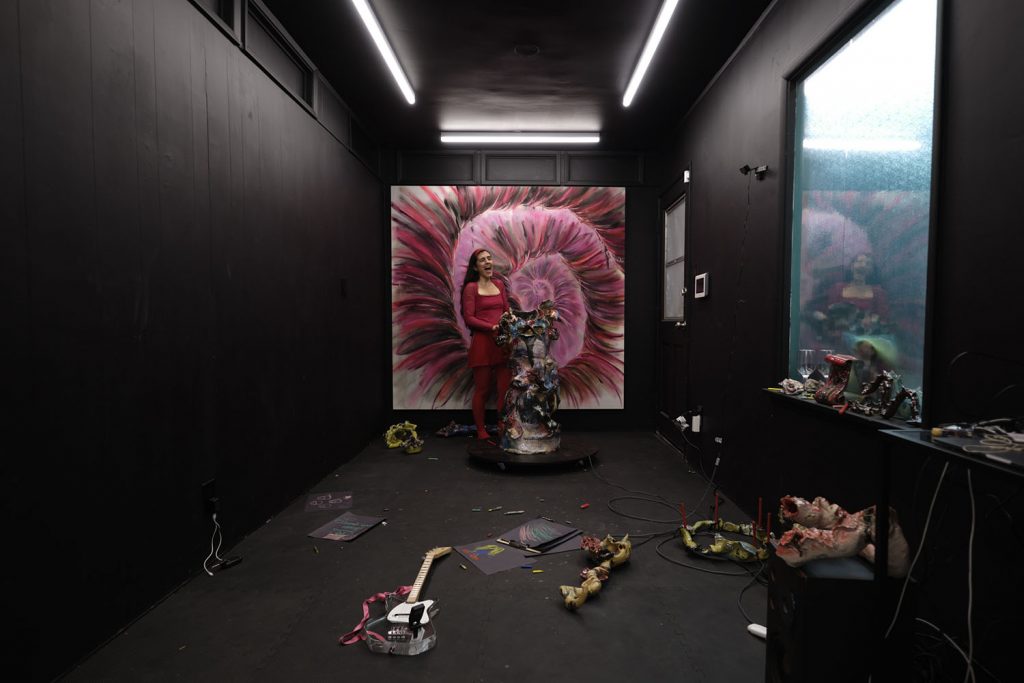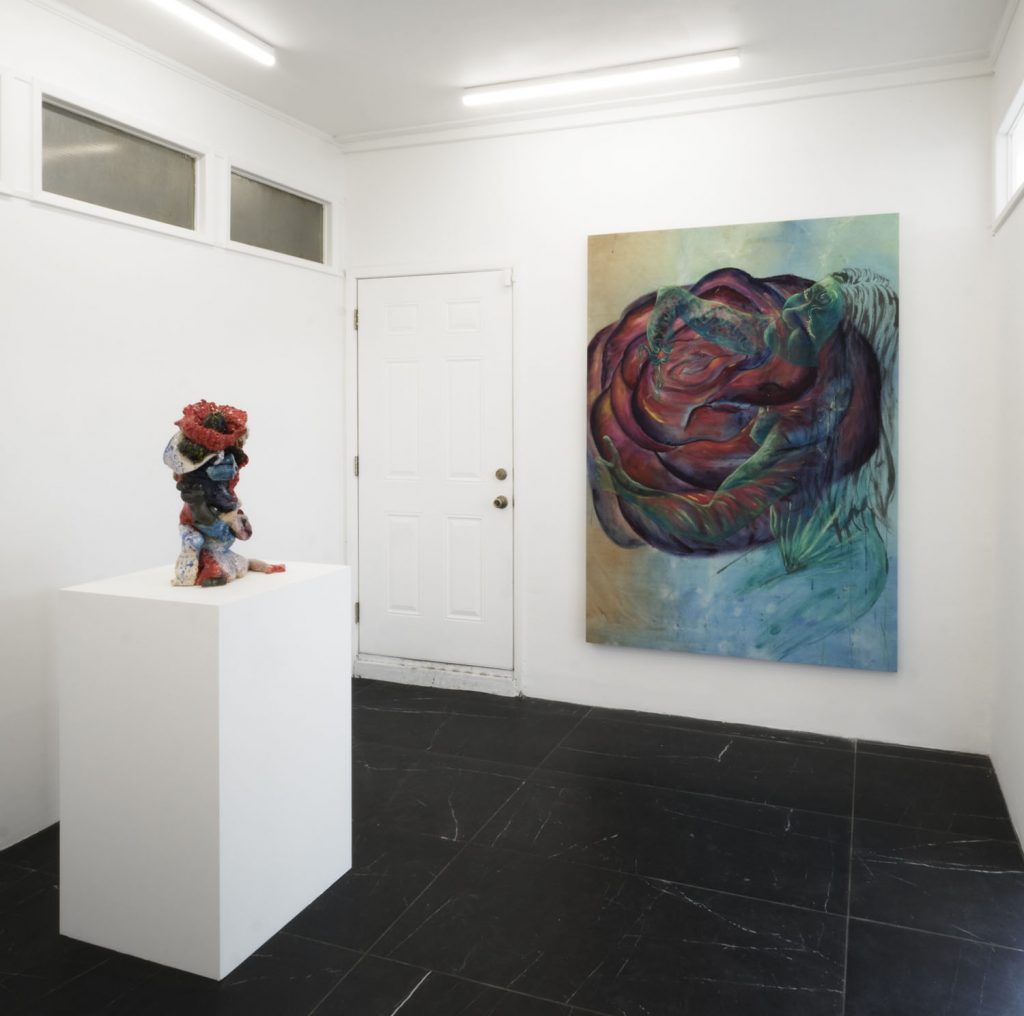Amidst the pestilence, misery and beige, wildfire haze of summer 2020, there was a curious performance at the banks of the concrete-filled Los Angeles River called ‘The Return’ by Sparkly Berman. A crowd of youth gathered for the performance, some masked, some unmasked, while the artist evaluated the condition of the onlookers with a general health questionnaire. Suddenly, an onlooker collapses, others panic and try to figure out which emergency number they should call. Dr. Panacea, the character Sparkly is currently inhabiting, is at first unsure of what medicine to offer, and switches to the character Kayla while babbling a bit like a child, but she carts away the patient who makes a quick and miraculous recovery. A miracle has been rendered.

Roughly nine months later, another series of performances inaugurated Berman’s Miracle Zone solo exhibition of ceramics, painting and durational performance at Los Angeles’s Le Maximum in and running May 15 to June 27. A thorough array of vividly-colored new work is on view in the front galleries of the Venice space, but behind a large painting is the namesake artwork of the show—a performance installation of sound, sculpture, web cameras and movement that also holds the artist’s corporeal presence. Three days each week, Sparkly presents the titular ‘Miracle Zone’ performance to any gallery visitor in attendance from the backroom, or also on Twitch at her dedicated channel. Visitors are offered participatory rituals and resurrections, similar to last summer’s ‘The Return’, where the artist brings back a selected gallery visitor from death—either spiritual or physical, or both.
It is hard to evaluate and discuss performance art in the immediate aftermath of the COVID-19 pandemic and ongoing social upheaval. Gathering amongst others itself still feels like a triumph, but there are lingering questions now as to which ends we gather. Is it to connect, heal, riot, enrich, destroy, or, quite simply, get fucked up as its own remedy? Berman offers clues in her work and practice, especially towards those areas that have gone unnoticed and underappreciated over the past 16 months.
Unlike the well-worn ‘return to nature’ calls of communes from the 60s and 70s counterculture, Berman’s practice is noticeably embracing of the digital, or more specifically the areas in which physicality dissolves into a set of transfers and flows. Her usage of Twitch is illustrative of this, despite being a platform known for its use by gamers and streamers, and perhaps a few accelerationist artists. The live video service embraces self-staging and performative expression that emphasizes pure presence beyond the kind of monetized rigidities that factor into other technologies like Zoom, Clubhouse or Instagram. On Twitch, Berman’s paintings as part of the Miracle Zone, serve as kinds of energy maps, while the ceramics offer physical platforms towards the creation of music, sound and performance.

Though the name ‘Miracle Zone’ almost toys with a 90s Captain Planet-like nostalgia, the show seemingly engages with rich art historical precedents of the esoteric intersecting with art and performance. In Berman’s practice are traces of Wallace Berman’s (no relation) psychedelic work, inspired by the esoteric Jewish Kabbalah, which, as one writer put it, is “meant to explain the relationship between an unchanging, eternal, and mysterious infinity and the mortal and finite universe”. There are also hints here of James Lee Byars’ immersive performance installations. Mike Kelley’s work seems to especially loom large in relation to the human legacies of pain, healing and transformation that Berman also sets out to either highlight or heal.
Kelley long integrated music and performance in his work. His and Tony Oursler’s The Poetics Project 1977 – 1997 is one notable example where the artists broadened the scope of an artwork to incorporate painted panels, projected video, sculpture, music and drawing, all within a framework of conceptual art and performance. Echoes of this piece can be seen in the Miracle Zone, where there is really no distinction between the ceramic works, paintings and the contact microphones, pads, webcams, paints and pedals throughout the room, amplifying and manipulating sound and material. A soundtrack by Maxwell Sterling accompanies each performance, with Berman adding sound through both her own agency and others’ in the gallery.

At a deeper level, the artist works in a psychic area near to where Kelley focused on portrayals of trauma and lost innocence. Though Kelley did grow up in a strict midwestern Catholic family, he never identified anything particularly painful that he went through as a child. He wrote in 1996, “There was simply nothing I could do to counter the pervasive psycho-autobiographic interpretation of these materials. I decided, instead, to embrace the social role projected on me, to become what people wanted me to become: a victim.” It is an open question whether this sense of victimhood sadly overtook the artist upon his tragic passing in 2012.
Yet, whereas Kelley’s work fed into the allure or the appearance of an infinitely broken psyche, Berman’s work acknowledges legacies of pain and limitation up front, and seeks to form new pathways of connection using widely available means. At a time when contemporary art feels more than ever concerned about checking boxes, the Miracle Zone seems to reflect back at us: why are we so concerned with these boxes?••













